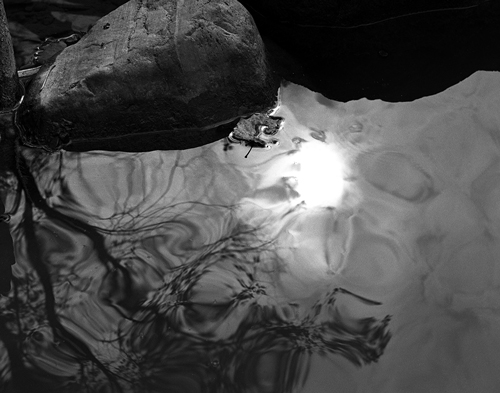
| |
Designated an American Heritage River for its cultural, environmental, and economic importance to the region, the Cuyahoga also holds the dubious distinction of spontaneously catching fire eleven times from toxic pollutants in the water near Cleveland. An article in Time magazine suggested that if a person fell into the river, they would "not drown but decay." Thus, I became interested in the contemporary paradox found in nature from an early age. The land offers its own powerful presence as well as a surfeit of metaphors and stories that capture my heart and mind. But the land also represents human folly and the abusive legacies of modernity. Since the beginning of my life as a photographer, I have held the question of where to stand amidst these opposing forces. In mid-life, I moved to Hawai'i to complete an ongoing photographic project on the land and cultural sites of the islands. The mountains, valleys, and ocean are strikingly beautiful with a unique power and force. The landscape of Hawai'i generously reveals the evidence of the forces which shaped, and continue to shape, its existence. The action of volcano, wind, water, and the presence of people — both ancient and modern — have left their distinct marks, resulting in a land of great mystery, beauty, and lingering conflicts. Deeply infused with Polynesian and Asian culture and colonized by Western missionaries during the nineteenth century, Hawai'i embraces an extraordinary diversity of thought, traditions, and people. Over time, I developed great respect for the Hawaiian mode of perception—particularly of land and water. Aloha 'aina (love of the land) is one of the most-cherished guiding Hawaiian values. John Charlot writes in Chanting the Universe: Hawaiian Religious Culture (1983), "In Hawaiian sensitivity and thought, the seamless joining of physical description and symbolic meaning is symptomatic of the way the Hawaiian actually sees nature: not as bare fact, but as permeated by all the dimensions he senses in his existence." In their creative expression there is a "complex interaction between . . . attention to the place itself and to its symbolic connotations."
Hawaiian monarch King Kamehameha uttered a phrase upon the return of Hawaiian sovereignty after a brief takeover by the British in 1843, which has become the state motto and reads, "The life of the land is perpetuated in righteousness." In Hawaiian thought, the land is seen as a living being that cannot be possessed—the vehicle through which unseen forces pass, a link to the earthly presence of the gods. The central conflict of land use in Hawai'i revolves around the fact that Western interests view the land as a commodity—something to be bought or sold and used an even exploited for economic gain. The landscape of Hawai'i can be seen as a microcosm that typifies the struggle for Indigenous rights on the planet and serves as a symbol for the rights of Earth worldwide. The forces of modernization and economic progress often pillage the earth and exenterate the soul of native traditions and spiritual values. I wish that my work can help us on the path towards finding a sustainable future for Earth and for sensitive land use and respect for all cultures and peoples—with the recognition of a shared radiance found in all of life. My creative intent in the photographs that comprise Oceano: An Elegy for the Earth revolves around the dynamic tension between reality and metaphor—a search for the radiance, the luminosity that James Joyce believed is the only true subject of art, balanced against darker truths, expressed symbolically, of my experiences with injustice and disharmony in an increasingly shattered world. I strive to perceive the living energy of the land and to represent its deep link to human experience and awareness. For me, the true purpose of art is to expand one's consciousness, enlarge one's perspective, and evolve one's understanding of the world and of others. As consciousness transforms through making and viewing art, so do our actions and interactions with life, leading to greater empathy, justice, and enlightened decision-making. Copyright © 2022 David Ulrich. All rights reserved.
|

